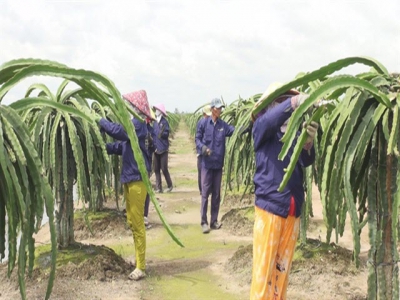Off-season dragon fruit fetches high price for Tiền Giang farmers

TIỀN GIANG — Farmers in the Cửu Long (Mekong) Delta province of Tiền Giang have begun harvesting off-season dragon fruit, earning high incomes.
Farmers tend dragon fruit in Tiền Giang Province’s Tân Phước District. — VNA/VNS Photo Nam Thái
In recent years, farmers have been using advanced farming techniques to grow off-season dragon fruit to avoid an oversupply during the main harvest season. The off-season is normally between December and March, with harvests three to four times a year.
Sáu Long, who has a 1.1ha red-flesh dragon fruit orchard in Chợ Gạo District, had a yield of one tonne of dragon fruit in the first off-season harvest and sold the crop for VNĐ28 million (US$1,200).
Traders have bought red-flesh dragon fruit for VNĐ28,000 a kilogramme, up VNĐ6,000 compared to last month.
Trần Văn Chơn in Chợ Gạo’s Trung Hòa Commune said he would harvest nearly two tonnes of off-season dragon fruit in the next few days.
With the increase in price, he expects to earn a high profit, he said.
Chợ Gạo District, which has the largest dragon fruit growing area in the province, has more than 4,500ha, mostly red-flesh dragon fruit with an average yield of 30 tonnes per hectare a year, according to the district’s Bureau of Agriculture and Rural Development.
Trần Văn Hòa, head of the bureau, said that dragon fruit is the district's specialty fruit and is mostly exported, with China the largest export market.
To promote dragon fruit cultivation, authorities have provided farmers with advanced farming techniques to produce off-season dragon fruit.
They have also introduced cultivation models under which Vietnamese and global good agricultural practices (VietGAP and GlobalGAP) are applied.
Farmers are encouraged to join co-operatives and co-operative groups.
Lê Văn Thủy, a member of the Mỹ Tịnh A Dragon Fruit Co-Operative in Chợ Gạo District, said: “In a co-operative, farmers enjoy many benefits like guaranteed outlets and advanced farming techniques.”
Participating farmers can buy input materials with deferred payments and are given part of the cost for applying for VietGAP certificates, he said.
As a member, Thủy earns a profit of VNĐ500 million ($21,700) a year from his 1.1ha dragon orchard.
The Mỹ Tịnh A Dragon Fruit Co-Operative has 30ha of dragon fruit planted to GlobalGAP standards.
The co-operative has worked with companies in HCM City to export dragon fruit to many countries, including the US.
Dragon fruit co-operatives in the province have established dragon fruit growing areas that meet VietGAP or GlobalGAP.
The province’s dragon fruit farmers can earn an average profit of VNĐ300-360 million ($13,000-15,600) per hectare a year, according to the province’s Department of Agriculture and Rural Development.
Tiền Giang, the country's largest fruit producer, has more than 8,400ha of dragon fruit, accounting for about 10 per cent of the province’s total fruit area.
Có thể bạn quan tâm
 Secrets of a visionary fruit farmer
Secrets of a visionary fruit farmer Workers are divided into small teams, each with a supervisor to ensure quality work. Goals are set and targets must be reached.
 Agriculture in a position to grow
Agriculture in a position to grow Investment in digitalizing the agriculture sector is coming but progress is slow due to long-standing issues.
 Agricultural land accumulation: Enterprises and farmers meet with difficulties
Agricultural land accumulation: Enterprises and farmers meet with difficulties Many enterprises orient to develop high-tech agriculture so a large area of agricultural land is needed for production.